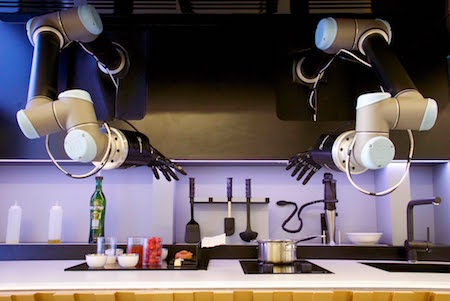Utilising a pair of fully articulated hands Moley is able to emulate the entire range of human movements with the same speed and sensitivity. The movements and skills of BBC Master Chef winner Tim Anderson were recorded onto Moley’s system, so that the robotic hands could replay them exactly, and adapt them for future recipes. An iTunes-style library of recipes pairs with the technology, allowing access to any recipe via ingredient preference, with the capacity for future recipes to be downloaded.
But what does this mean for chefs today? Should they fear for their jobs if Moley makes an appearance in people’s homes? With the possibility that they can 3D record their recipes for Moley, or a future kitchen AI to replicate, means that they could be selling their recipes one by one via smart phone apps for the consumer at home to enjoy.
The feature of reducing human cooking time in the home is an attractive proposition for many, if the technology can become affordable and easily set up in the home, and could well catch on sooner rather than later. In the professional kitchen, it could easily free up the master chefs’ time and efforts.
While Moley is likely to cost some jobs in the food service industry, it could well help in innovation, allowing human chefs more time for cognitive tasks, such as recipe invention and exploration, which is beyond Moley’s capabilities at the moment.


.jpg)
.jpg)
.jpg)

.jpg)



.jpg)
